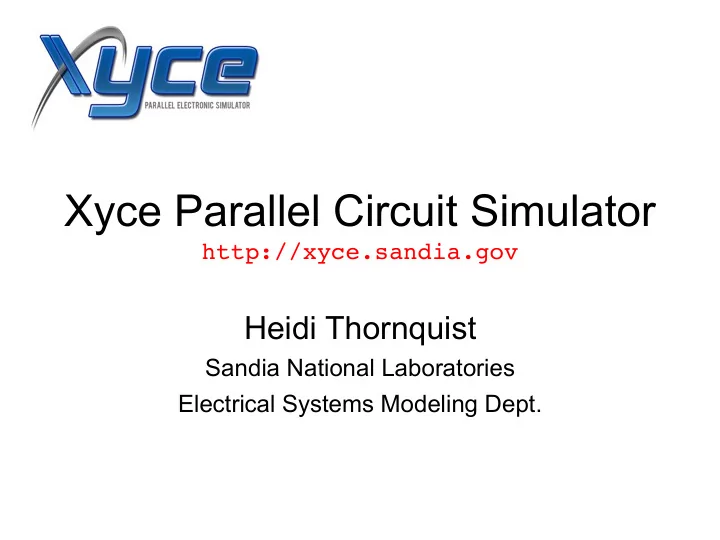

Xyce Parallel Circuit Simulator http://xyce.sandia.gov Heidi Thornquist Sandia National Laboratories Electrical Systems Modeling Dept.
A) Project Overview • The project: Large-scale analog circuit simulation • Science goals: Enable predictive simulation of large circuits in normal and hostile environments • The team: 6 developers, differing backgrounds & levels of participation • History: Project started 10 years ago – NNSA shift from test-based to simulation-based confidence • Sponsor: ASC • Goals: To develop a simulator, competitive with
B) Science Lesson • Xyce is an analog circuit simulator (SPICE compatible) • Models network(s) of devices coupled via Kirchoff’s current Kirchoff ʼ s Current Law (KCL) and voltage laws (modified KCL) – Most equations are Kirchoff Current Law (KCL) equations. Kirchoff ʼ s Voltage Law (KVL) – Most solution variables are nodal voltages. – Most currents are obtained via
C) Parallel Programming Model • Parallelism: MPI, with some OpenMP • Language: C++ • Libraries: Trilinos, LAPACK/BLAS, Zoltan/ ParMETIS, AMD (SuiteSparse) • Other infrastructure: None • Platforms: Unix/Linux, Windows, OSX • Current status: Migration to a hybrid model, that employs more threading for smaller-scale computations (device evaluation, etc.)
D) Computational Methods • Algorithms: implicit time integration (trap, BDF), nonlinear solver (Newton ʼ s method), linear solver (KLU, Ksparse, preconditioned GMRES) • FFT needed for frequency analysis methods, like harmonic balance (HB) • Currently developing scalable, robust parallel preconditioners, parallel HB capabilities, AD for faster, error-free model development
E) I/O Patterns and Strategy • Input I/O and output I/O patterns: – Input: Single netlist file, read in on proc 0. Minimal processing on proc 0 before device lines streamed to all other processors. – Output: Single output file containing requested circuit information (voltages, currents, etc.) • Approximate sizes of inputs and outputs – Netlist files can be large for modern ASIC designs – Output file size depends on amount of information requested and simulation parameters • Checkpoint / Restart capabilities: – Can dump DCOP solution for restart • Current status and future plans for I/O
F) Visualization and Analysis • How do you explore the data generated? – ASCII file output (Matlab, GNUplot, etc.) • Do you have a visualization workflow? – Not currently, our customers do more visualization than us • Current status and future plans for your viz and analysis – Working on visualization techniques for large ensemble calculations (UQ studies)
G) Performance • What tools do you use now to explore performance: – None • What do you believe is your current bottleneck to better performance? – Parsing and better linear solvers. Threading can provide a minor performance improvement. • What do you believe is your current bottleneck to better scaling? Scalable iterative linear solvers • What features would you like to see in perf tools – Ease of instrumentation and different measurements • Current status and future plans for improving
H) Tools • How do you debug your code? – Purify, gdb, valgrind, std::cout/printf • What other tools do you use? – Version control (cvs), c[make/test/dash] • Current status and future plans for improved tool integration and support – Tool integration on as needed basis
I) Status and Scalability • How does your application scale now? – Some parts of the code scale reasonably well, linear solvers are the scaling bottleneck. • Where do you want to be in a year? – Better fine-grain parallelism, more robust solvers, higher capacity parsing capability (possibly parallel) • What are your top 5 pains? (be specific) – 1 (lack of a scalable linear solver), 2 (serial bottlenecks in parser), 3 (too slow on small circuits), 4 (hidden performance issues in simulator), 5 (underlying parallelization framework) What did you change to achieve current scalability? • – Separated device evaluation partitioning from linear solver partitioning
J) Roadmap • Where will your science take you over the next 2 years? – Larger ASICs to simulate in support of LEPs, possibly new compact models to correctly determine the physics. . Electrical system qualification, which incorporates numerical simulation evidence, is expected to be a growth area. • What do you hope to learn / discover? – More robust, scalable solution techniques. Eradicate performance issues for small-to-large scale circuit simulation. • What improvements will you need to make – Algorithms for preconditioned linear solvers, effectively integrating threading to achieve performance gains
Recommend
More recommend